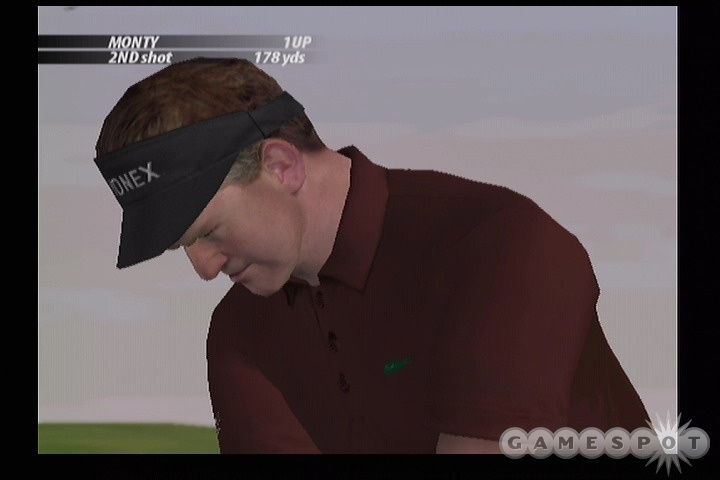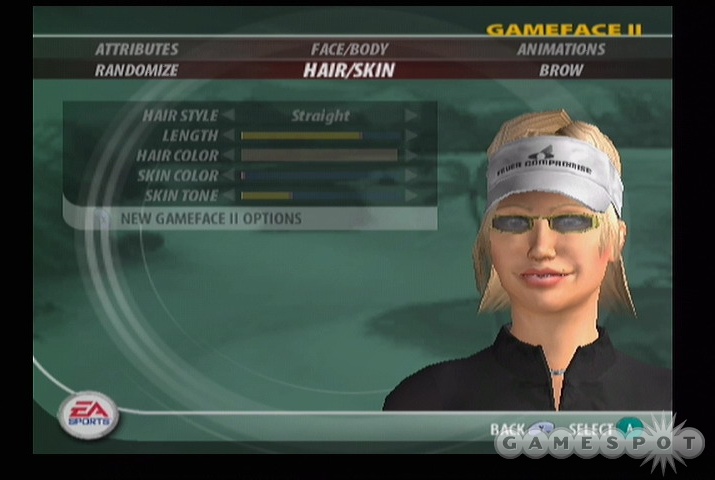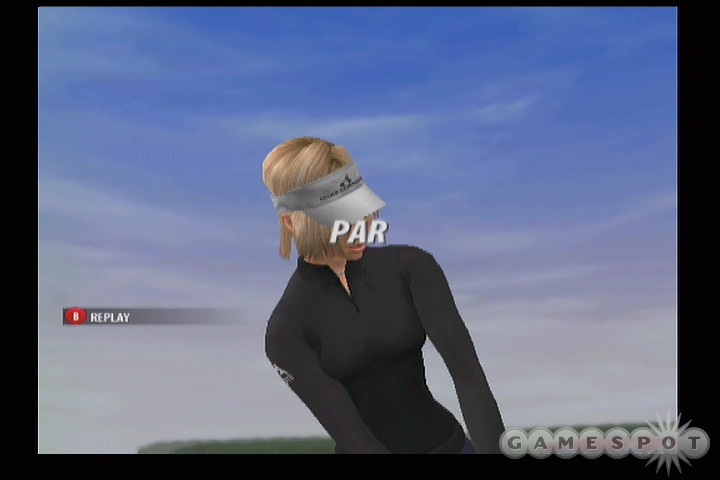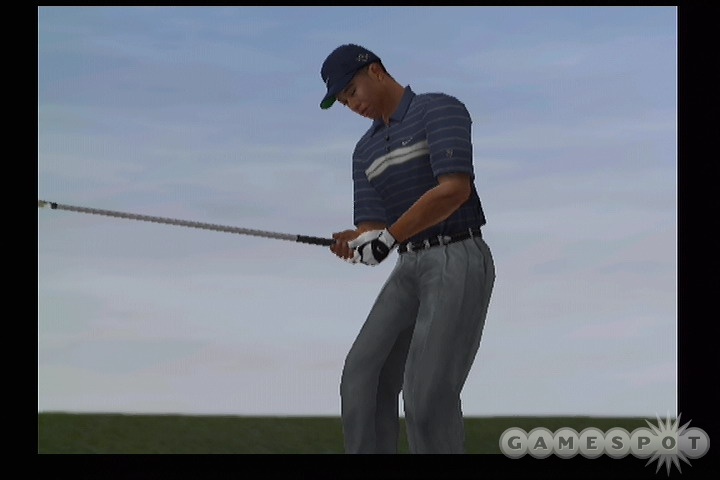For better or for worse, the game of golf has seen its image change quite dramatically over the past decade or so, shifting from a sport of privilege and exclusivity to something more accessible and populist. Tiger Woods, the golfer, has played no small part in this, and EA's Tiger Woods PGA Tour series has wisely broadened its own scope year after year, introducing non-traditional gameplay modes, exaggerated characters, and some good, tactile gameplay mechanics. Tiger Woods PGA Tour 2005 is the most approachable Tiger game yet, offering some appreciable improvements over last year's model and several significant features designed specifically to take some of the edge off the game. The game seems dead set on making new players comfortable--but this inadvertently sucks out a lot of the challenge.

Let's start with what's new this year. EA introduced its "Game Face" feature in last year's Tiger, which was a character creation system that allowed you to customize the appearance of your golfer to an almost absurd level. You were given a good half-dozen different variables for the appearance of your golfer's nose, for example. PGA Tour 2005 features an enhanced version of this feature, creatively dubbed "Game Face II," and it offers even more options and greater flexibility. There are a ton of new variables, many of which seem tailored toward creating a character with a more flawed appearance, including laugh lines, bags under the eyes, and crow's feet around the outer edges of the eyes. Game Face II seems to be more capable of handling extreme character designs. Before, if you wanted to make a morbidly obese or incredibly gaunt golfer, you could only go so far before it started looking unnatural. Now you can make such characters look appropriately lifelike.
Also included in this customization suite is a new swing editor, which allows you to tweak the bend of your knees and the positions of your hands and wrists at the three different stages of your swing, as well as the total length of your swing and the focus of your technique. With this fairly modest number of options, you can create some pretty bizarre-looking swings. The Game Face feature has always ostensibly existed for the purpose of creating a fair facsimile of yourself, and Game Face II definitely brings things closer.
Alongside the PGA tour mode, which has been the heart of the Tiger Woods games for years, Tiger 2005 introduces the legends mode, which is divvied up into two portions. There is the legend tour, which gives you the chance to play against six of the most legendary names in golf: Arnold Palmer, Jack Nicklaus, Ben Hogan, Gary Player, Seve Ballesteros, and finally, Tiger Woods himself. But before you can take on the legends, you'll need to win a series of match games against a mix of colorful fictional characters and real-life PGA pros. The addition of these well-respected names to Tiger's already brimming roster of real-life PGA pros adds a certain esteem to the affair. Yet for all the seriousness these revered golfers bring, the caricatured characters created by EA (seemingly with the game's own Game Face II tools, at that) basically negate it with an excess of funny nicknames, funnier haircuts, goofy victory dances, and improbable swing styles. Granted, the Tiger Woods PGA Tour games have always included a set of non-traditional player characters, but the wackiness level in this year's batch is too extreme and feels a little too contrived. Golf isn't the uptight sport it once was, but still, the tone in Tiger 2005 is different enough that fans of the sport, or fans of past Tiger Woods games, may be put off by it like we were.
The other half of the legends set is the legend scenario mode, which is essentially a repackaged version of the scenario mode from the past few Tiger Woods PGA Tour games. As before, these scenarios present you with a series of specific challenges, whether it's coming back from a string of bogeys or playing the toughest greens the game has to offer. As established Tiger players should expect, these scenarios are rather good at testing specific sets of skills.

Beating your competitors in the legend tour and winning medals in the legend scenario mode both earn you a fairly substantial cash prize. They also score you legend coins, which you can use to purchase courses for "Tiger proofing." Tiger proofing is essentially a very lightweight course editor that gives you a certain amount of control over the size and condition, but not the location, of different course elements. Greens and fairways can be shrunk, undulations can be added to the turf, hole placement can be changed, bunker depth can be increased, and so on. There are more than 20 different variables in total, many of which you'll have to unlock by earning more legend coins. Though it's no substitute for a full-featured course editor, Tiger proofing can be good for freshening up courses that you think you've already mastered.
As mentioned earlier, Tiger 2005 makes a serious effort to take some of the stress out of golfing, and this is most apparent with the new "Tiger vision" feature. Tiger vision is used when you're on the green, setting up for a particularly challenging putt, at which time you'll be shown exactly where you need to aim in order to sink the shot. The game is understandably tightfisted with the number of times you can activate Tiger vision (it can be enabled once or twice during a game), but this feature is still indicative of what seems to be the underlying philosophy in Tiger 2005. The actual mechanics of the gameplay remain unchanged from last year, with the same analog swing controls, but everything seems much more forgiving this time around. The analog swing doesn't feel as sensitive--so much so that, at times, it felt almost difficult for us not to smack the shot right down the middle of the fairway. As long as the green doesn't have a lot of weird contours to it, sinking shots from 20 feet away doesn't require much effort, either, and chip-in shots almost seem easier to pull off than actual putting. We found ourselves playing with brand-new characters and stock sets of clubs, and then coming away from 18-hole PGA Tour-grade courses at eight or nine under par.
While the feeling that you're a real PGA superstar is a great one, sinking an eagle shot doesn't feel quite as special if you find it happening in every game you play. One of the great strengths of the Tiger Woods series has always been its ability to play to both the casual players and the serious golf enthusiasts, but Tiger 2005 definitely feels pitched toward the new guys. Several hours of play will eventually unlock "tour difficulty," which turns off some of the assistant mechanics that are on by default, but it doesn't actually change the sensitivity of the analog controls and it doesn't make the putting any less forgiving.

Outside of all these additions and changes, Tiger Woods PGA Tour 2005 is still, basically, the same old Tiger. You can still play a quick one-off game of your choice, be it stroke, match, skins, stableford, or fourball, and the skill zone still offers a nice variety of minigame-style challenges. The game introduces several new real-life courses to play on, as well as a few fantasy courses; unfortunately, many of the courses included in Tiger Woods PGA Tour 2004 have been omitted, dropping the total number of playable courses from 19 to 14. It's still a solid collection of courses that cover a great variety of locations, but it's a shame that classic courses like TPC Scottsdale and Spyglass Hill aren't included.
Tiger Woods PGA Tour 2004 was the first in the series to introduce online play, though it was only available on the PlayStation 2 version. This year it comes to the Xbox as well, and both versions have basically identical online capabilities, letting you play one-on-one with another player or compete in EA-sponsored online tourneys. Though the online is completely functional, it's not really much improved over the online support in Tiger 2004 for the PS2.
Though the visuals have received minor touch-ups year after year, the core graphics engine that powers Tiger Woods has been pretty much the same for the past three years. Tiger 2005 makes some modest improvements over the graphics in Tiger 2004, with the player models looking more realistic and emotive than ever, but there are other aspects of the visuals that are now starting to show their age. When you're doing a flyby, everything still looks nice and realistic, but it doesn't hold up as well upon close inspection. A lot of the foliage surrounding the courses has a kind of flat look to it, the picket fence-like rows of grass blades that make up the rough are plainly visible, and some of the fairway and green textures can look a little blurry. The series really started to establish its own visual flavor back in Tiger Woods PGA Tour 2003, when it introduced a bevy of dramatic camera effects to give more impact to powerful tee shots and make tense approaches and putts even more nail biting. Tiger 2005 maintains these designs. This year, EA has done away with many of the older shots and introduced a whole new set of crazy effects, which include a sepia-tone effect and a zoomed-in shot that follows the ball off the tee. Some of these effects are quite effective, but their overall quality just doesn't seem quite as consistent as in the past.
All three console versions of Tiger Woods PGA Tour 2005 are pretty much comparable in terms of content and quality, though there are a few system-specific idiosyncrasies. The graphics on the PlayStation 2 seem especially aliased, and along with a lack of online support, the textures in the GameCube version seem to have just a bit less clarity than the other two versions. And, like last year's Tiger, the GameCube version of Tiger 2005 comes on two discs, which is a testament to the amount of content contained within the game, to be sure, but having to swap between discs at seemingly arbitrary points in the game is a hassle. Most of the differences are ultimately pretty nominal, but when compared side-by-side-by-side, the Xbox version definitely has the greatest graphical fidelity.
Gary McCord and David Feherty have been the commentary team for Tiger Woods PGA Tour for years now, and you can tell this by how comfortable they sound in Tiger 2005. Their delivery is natural and unhurried, and more irreverent than ever. Even though this means you'll have to hear a few more bad puns from Feherty, it can be amusing when one of them miscalls a shot and the other chides him for it. Outside the commentary, the sound is pretty good, though some of the "wackiness" creeps into the environmental sounds. The most obvious example of this is the sound of another golfer shouting "fore!" followed by the sound of breaking glass and a car alarm. It's kind of clever the first time you hear it, but the joke doesn't really stand up to multiple plays.

Though Tiger Woods PGA Tour 2005 is still enlisted in the EA Sports Trax program, it doesn't have quite the same weird mishmash of artists that has been indicative of the Trax program thus far. Save for the inclusion of OutKast's "The Way You Move," which plays by default at so many of the menus that, despite being catchy, it quickly wears out its welcome, the rest of the music in the game is provided by dance music producer BT. The soundtrack has a uniformly relaxed ambience to it. Rather than vie for your attention, the soundtrack here does what it should: complement the visuals and help establish the mood.
From strictly a bullet-point perspective, Tiger Woods PGA Tour 2005 is a more full-featured game than last year's (with the notable exception of the smaller number of courses), and it still stands as one of the best games of golf for the PlayStation 2. However, many of its improvements over Tiger Woods PGA Tour 2004 feel kind of incremental, and unless you're an Xbox owner who is itching to take the game online, owners of Tiger 2004 shouldn't necessarily rush out to pick it up.